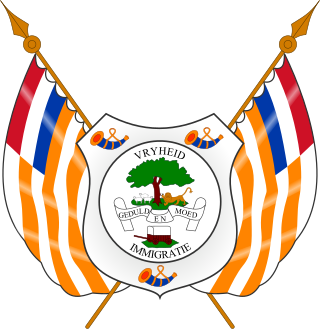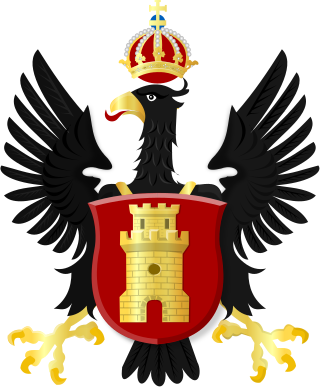In heraldry, gules is the tincture with the colour red. It is one of the class of five dark tinctures called "colours", the others being azure (blue), sable (black), vert (green) and purpure (purple).

Prince of Orange is a title associated with the sovereign Principality of Orange, in what is now southern France and subsequently held by the stadtholders of, and then the heirs apparent of, the Netherlands.

The coat of arms of the Kingdom of the Netherlands was originally adopted in 1815 and later modified in 1907. The arms are a composite of the arms of the former Dutch Republic and the arms of the House of Nassau, it features a checkered shield with a lion grasping a sword in one hand and a bundle of arrows in the other and is the heraldic symbol of the monarch and the country. The monarch uses a version of the arms with a mantle while the government of the Netherlands uses a smaller version without the mantle (cloak) or the pavilion, sometimes only the shield and crown are used. The components of the coats of arms were regulated by Queen Wilhelmina in a royal decree of 10 July 1907, affirmed by Queen Juliana in a royal decree of 23 April 1980.

The coat of arms of Scotland, colloquially called the Lion Rampant, is the coat of arms historically used as arms of dominion by the monarchs of the Kingdom of Scotland, and later by monarchs of Great Britain and the United Kingdom. The coat of arms, or elements from it, are also used in heraldry to symbolise Scotland in general. The arms consist of a red lion surrounded by a red double border decorated with fleurs-de-lis, all on a gold background. The blazon, or heraldic description, is: Or a lion rampant Gules armed and langued Azure within a double tressure flory-counter-flory of the second.

In heraldry and heraldic vexillology, a blazon is a formal description of a coat of arms, flag or similar emblem, from which the reader can reconstruct the appropriate image. The verb to blazon means to create such a description. The visual depiction of a coat of arms or flag has traditionally had considerable latitude in design, but a verbal blazon specifies the essentially distinctive elements. A coat of arms or flag is therefore primarily defined not by a picture but rather by the wording of its blazon. Blazon is also the specialized language in which a blazon is written, and, as a verb, the act of writing such a description. Blazonry is the art, craft or practice of creating a blazon. The language employed in blazonry has its own vocabulary, grammar and syntax, which becomes essential for comprehension when blazoning a complex coat of arms.

The coat of arms of Amsterdam is the official coat of arms symbol of the city of Amsterdam. It consists of a red shield and a black pale with three silver Saint Andrew's Crosses, the Imperial Crown of Austria, two golden lions, and the motto of Amsterdam. Several heraldic elements have their basis in the history of Amsterdam. The crosses and the crown can be found as decorations on different locations in the city.
Danish heraldry has its roots in medieval times when coats of arms first appeared in Europe. Danish heraldry is a branch of the German-Nordic heraldic tradition.

The study of Dutch heraldry focuses on the use of coats of arms and other insignia in the country of the Netherlands. Dutch heraldry is characterised by its simple and rather sober style, and in this sense, is closer to its medieval origins than the elaborate styles which developed in other heraldic traditions.

A Frisian eagle is a specific kind of eagle in Dutch heraldry, consisting of half of a black double-headed eagle on the dexter side of a shield parted per pale.

The coat of arms of the Orange Free State was the official heraldic symbol of the Orange Free State as a republic from 1857 to 1902, and later, from 1937 to 1994, as a province of South Africa. It is now obsolete.

The coat of arms of the Transvaal was the official heraldic symbol of the South African Republic from 1866 to 1877 and again from 1881 to 1902, and later the symbol of the Transvaal Province from 1954 to 1994 in a simplified form. It is now obsolete.

The coat of arms of Sint Eustatius consists of a shield and the motto. It was established on 9 November 2004 by the Island council of Sint Eustatius, when it was still part of the Netherlands Antilles. It remained the coat of arms of Sint Eustatius after the dissolution of the Netherlands Antilles and the subsequent change of Sint Eustatius's constitutional status into a special municipality of the Netherlands in 2010.

The emblem of Curaçao is a yet to be adopted national symbol of Curaçao. The design will be based on a concept by Adresetti Monart featuring the Queen Emma Bridge, a cactus, a hummingbird and a traditional fishing boat, which was chosen through a design competition held in 2022. The emblem is set to replace the coat of arms of Curaçao, which has been in use since 24 July 1964.

The coat of arms of Beverwijk is a coat of arms that has been renewed several times. The coat of arms of Beverwijk is the only coat of arms of a Dutch municipality that is surrounded by a cloak. This is highly unusual in the Netherlands, where such a cloak is normally reserved for nobility, the pope and national coats of arms.

The coat of arms of Zaanstad has been formally acknowledged since 27 February 1974. The coat of arms was previously that of the jurisdictional area of Westsane en Crommenie, which now form the municipality of Zaanstad. These two areas were on the same areas as the municipalities who fused in 1974 to become the municipality of Zaanstad. The municipality of Assendelft alone used a coat of arms who didn't look like those of the other municipalities. The other municipalities and places used a coat of arms with four lions in it.
This page shows the coats of arms, heraldic achievements, and heraldic flags of the House of Nassau.

The coat of arms of the municipality and town of Weert in Limburg in the Netherlands was assigned to the municipality on 16 November 1977 by royal decree by the High Council of Nobility. It replaced the first coat of arms from 1918.

The coat of arms of Middelburg is a canting coat of arms. It stands for the castle (Dutch: Burcht / Burg) of Middelburg, which was in the middle-ages located between two other castles, Domburg and Souburg. The tower in the coat of arms is also present in the flag of Middelburg. The colours probably originate from the coat of arms of the viscounts of Zeeland, they carried a coat of arms of a golden lion on a red background in the 13th century.





















